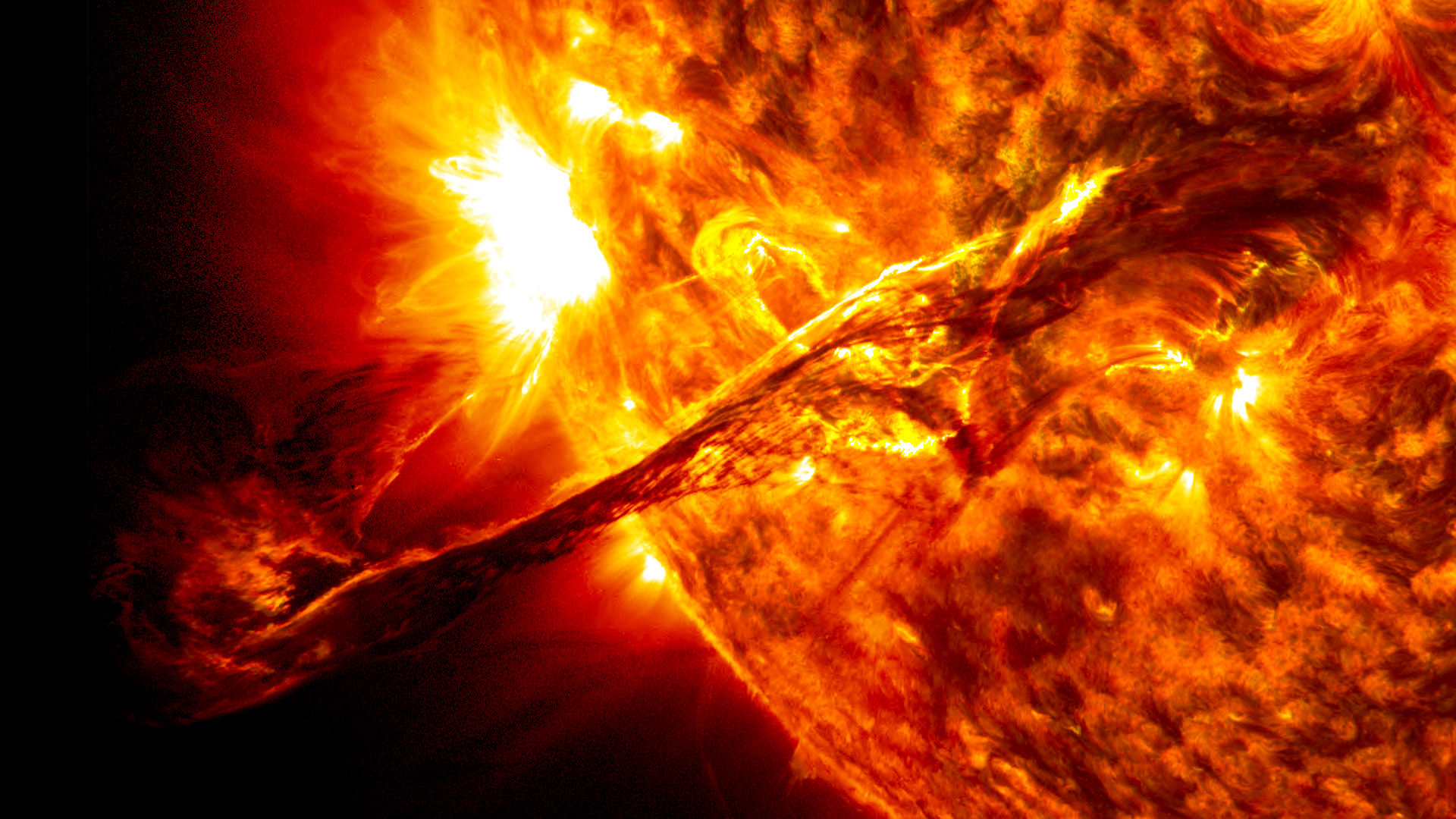Mega plasma ball erupted from a sun-like star. It was 10 times larger than any ever seen.
The coronal mass ejection hints at what our sun may be capable of.

A baby version of the sun recently let off an eruption of magnetic plasma gas 10 times larger than any ever seen from a sun-like star, according to new research.
The star, EK Draconis, is only about 100 million years old, meaning it looks like Earth's sun about 4.5 billion years ago, said study leader Yuta Notsu, a research associate at the Laboratory for Atmospheric and Space Physics at the University of Colorado, Boulder. The findings suggest the sun is capable of belching out coronal mass ejections (CMEs) — bubbles of plasma gas — larger than any directly observed so far. However, because the sun is older than EK Draconis, it's likely to be calmer, with enormous CMEs occurring fewer and farther between.
Still, understanding the upper limits of CMEs are important, because these energetic, magnetic eruptions interact with Earth's atmosphere, potentially causing geomagnetic storms that can disrupt satellites, cause electrical blackouts, and disrupt the internet and other communications. CMEs are also a potential danger for crewed missions to the moon or Mars; these solar storms send out streams of high-energy particles that can expose anyone outside Earth's protective magnetic shield to as much radiation as 300,000 chest X-rays at once, according to NASA. That's a fatal dose.
Notsu and his colleagues reported in 2019 that sun-like stars are capable of producing large bursts of electromagnetic radiation called superflares. The researchers found that young sun-like stars give off superflares on a weekly basis, whereas older stars like Earth's sun produce them less frequently — perhaps every 1,000 years or so.
Superflares like these are bursts of electromagnetic radiation that aren't, in themselves, dangerous. But some proportion of superflares are followed by major CMEs, which can be dangerous. So Notsu and his team turned to EK Draconis to find out if superflares trigger major CMEs in young sun-like stars.
Using NASA's Transiting Exoplanet Survey Satellite (TESS) and Kyoto University's SEIMEI Telescope, the researchers peered through 111 light-years of space to observe the star between January and April 2020. On April 5, they got what they were looking for: a shift in the spectra of light given off by the star, indicating a blob of plasma traveling toward Earth.
The eruption was traveling at about 1 million mph (1.6 million km/h) and had a mass of more than 2 quadrillion pounds (1 quadrillion kilograms), 10 times the mass of any observed solar flare.
Sign up for the Live Science daily newsletter now
Get the world’s most fascinating discoveries delivered straight to your inbox.
"This is very helpful for estimating the possible CME with a superflare on our sun," Notsu said.
It would be easy to miss a once-in-a-thousand-year superflare; the first direct observation of a solar flare occurred in 1859, meaning humans have less than a 200-year direct record of the activity of the sun's surface and atmosphere. Before the advent of electronics, solar flares and geomagnetic storms were not very noticeable on Earth's surface. They might cause the aurora to become visible farther from Earth's poles, but there were no satellites or mass communications to disrupt — though the 1859 flare, known as the Carrington Event, did cause telegraph lines to spark and, in some cases, catch fire.
New research is hinting that the sun has given off some doozies in the distant past. Tree rings around the world record a jump in a radioactive form of carbon, carbon-14, in the years 774 and 775. A 2012 study found that whatever caused the increase was sudden and quick, pointing to a solar flare as the culprit, Live Sciene sister site Space.com reported. (When energetic particles from the sun penetrate Earth's magnetic shield, they can create radioactive versions of atoms, Notsu said.) In 2013, researchers found the same types of hints in ice cores, researchers said in the journal Astronomy & Astrophysics. A 2019 study found signs of a similarly large event in 2610 B.C. Another flare may have hit in the years 993 and 994, a 2013 study in the journal Nature Communications found.
The new observations of EK Draconis only captured the first phase of the CME, Notsu said. And researchers still aren't sure how many superflares end with CMEs and how many taper off without a plasma burst. More observations with different instruments can provide a bigger picture, he said.
Studying sun-like stars in their youth is important not only for planning for a potential coronal mass ejection catastrophe, Notsu said. It's also a window into the past of our own solar system. For example, scientists believe that Mars may once have had a thick, Earth-like atmosphere. One hypothesis holds that when Mars lost its magnetic field, high-energy particles from the sun began to chip away at this atmosphere, eventually leaving the planet barren and unprotected. This is controversial, though, as little is known about interactions between the sun and planets in the early solar system. These interactions may have been very different than what is observed today.
"We need more collaboration with planetary scientists to estimate more detailed effects on planets," Notsu said.
The findings appear Dec. 9 in the journal Nature Astronomy.
Originally published on Live Science

Stephanie Pappas is a contributing writer for Live Science, covering topics ranging from geoscience to archaeology to the human brain and behavior. She was previously a senior writer for Live Science but is now a freelancer based in Denver, Colorado, and regularly contributes to Scientific American and The Monitor, the monthly magazine of the American Psychological Association. Stephanie received a bachelor's degree in psychology from the University of South Carolina and a graduate certificate in science communication from the University of California, Santa Cruz.









